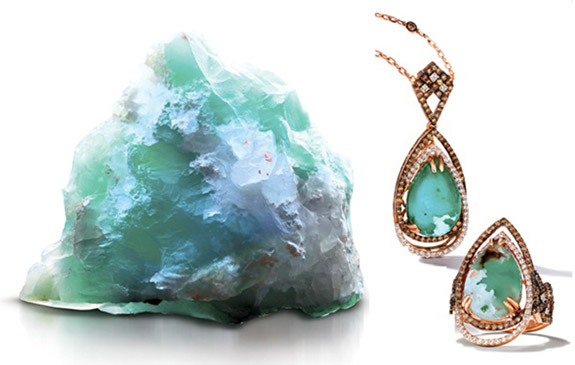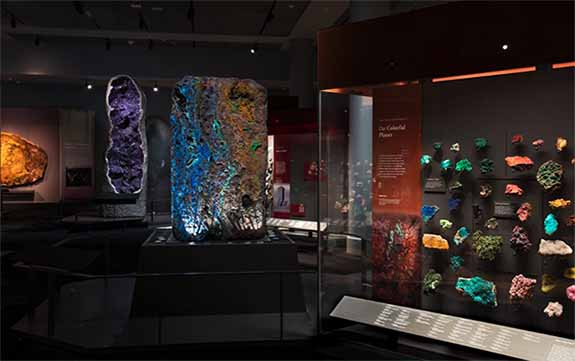September 14th, 2021
Back in February of 2016, the Gemological Institute of America identified a brand new variety of chalcedony — a fascinating gem that incorporated the colors of the sky, the sea and the earth. Dubbed “Aquaprase” by Greek gem explorer Yianni Melas, the translucent bluish-green specimens have been compared to the Aegean Sea when viewed from an airplane.

Billed as the 21st century's first gem discovery, the unique chalcedony caught the attention of luxury brand Le Vian, which has since trademarked the superior selections of the gem as Le Vian Peacock Aquaprase™.
Recently, Le Vian donated to New York City's American Museum of Natural History (AMNH) a selection of rough and polished Aquaprase gemstones, as well as Le Vian Couture jewels featuring the stone.

The donation was timed to coincide with the reopening of the completely redesigned and reinstalled Mignone Halls of Gems and Minerals. The 11,000-square-foot facility within the AMNH features more than 5,000 specimens sourced from 95 countries.
The Aquaprase selections will share the spotlight with other notable specimens, such as the legendary 563-carat Star of India sapphire, the 632-carat Patricia Emerald and the 9-pound almandine Subway Garnet that had been discovered under Manhattan’s 35th Street in 1885.
Melas first encountered Aquaprase in an undisclosed African country in 2013. He told JCK magazine in 2016 that he saw a sample of this unusual gem while visiting a friend’s hut. The specimen was displayed on a shelf and was in poor condition.
“I couldn’t explain why I thought it was different,” he told JCK. “It is like a third eye. I have seen thousands of stones and you get that feeling. When I picked up the stone, I had the chills, a funny feeling. That feeling is something you have to follow.”
He did some exploring to find more examples of this type of gem, but he wasn’t sure what it was, exactly.
Some associates guessed it was chrysocolla. Others said is was blue-green opal. Most thought it was chrysoprase.
To get a conclusive answer, he sent a sample to GIA.
“I heard nothing for three months,” he told JCK. “Then I got a phone call that said we found something incredible. It’s not a chrysoprase. It is not a chrysocolla. It’s a chalcedony that has never been discovered.”
The GIA reported that the new bluish-green variety of chalcedony gets its unique color from traces of chromium and nickel within the chemical makeup of the quartz stone. Previously identified varieties of chalcedony occurred in yellowish-green and greenish-blue colors.
Melas came up with the name “Aquaprase” by combining the word “aqua” (for the blue sea) with “prase” (meaning leek-green in Greek).
Although the rough material is available in “clean” varieties that are either vibrant blue-green or baby blue “with clouds,” Melas said he prefers the material with matrix, which is part of the surrounding rock.
Melas told JCK that the matrix looks more natural and gives the finished piece more character.
Credits: Aquaprase image courtesy of Le Vian. Mignone Halls of Gems and Minerals image by D. Finnin/© American Museum of Natural History.

Billed as the 21st century's first gem discovery, the unique chalcedony caught the attention of luxury brand Le Vian, which has since trademarked the superior selections of the gem as Le Vian Peacock Aquaprase™.
Recently, Le Vian donated to New York City's American Museum of Natural History (AMNH) a selection of rough and polished Aquaprase gemstones, as well as Le Vian Couture jewels featuring the stone.

The donation was timed to coincide with the reopening of the completely redesigned and reinstalled Mignone Halls of Gems and Minerals. The 11,000-square-foot facility within the AMNH features more than 5,000 specimens sourced from 95 countries.
The Aquaprase selections will share the spotlight with other notable specimens, such as the legendary 563-carat Star of India sapphire, the 632-carat Patricia Emerald and the 9-pound almandine Subway Garnet that had been discovered under Manhattan’s 35th Street in 1885.
Melas first encountered Aquaprase in an undisclosed African country in 2013. He told JCK magazine in 2016 that he saw a sample of this unusual gem while visiting a friend’s hut. The specimen was displayed on a shelf and was in poor condition.
“I couldn’t explain why I thought it was different,” he told JCK. “It is like a third eye. I have seen thousands of stones and you get that feeling. When I picked up the stone, I had the chills, a funny feeling. That feeling is something you have to follow.”
He did some exploring to find more examples of this type of gem, but he wasn’t sure what it was, exactly.
Some associates guessed it was chrysocolla. Others said is was blue-green opal. Most thought it was chrysoprase.
To get a conclusive answer, he sent a sample to GIA.
“I heard nothing for three months,” he told JCK. “Then I got a phone call that said we found something incredible. It’s not a chrysoprase. It is not a chrysocolla. It’s a chalcedony that has never been discovered.”
The GIA reported that the new bluish-green variety of chalcedony gets its unique color from traces of chromium and nickel within the chemical makeup of the quartz stone. Previously identified varieties of chalcedony occurred in yellowish-green and greenish-blue colors.
Melas came up with the name “Aquaprase” by combining the word “aqua” (for the blue sea) with “prase” (meaning leek-green in Greek).
Although the rough material is available in “clean” varieties that are either vibrant blue-green or baby blue “with clouds,” Melas said he prefers the material with matrix, which is part of the surrounding rock.
Melas told JCK that the matrix looks more natural and gives the finished piece more character.
Credits: Aquaprase image courtesy of Le Vian. Mignone Halls of Gems and Minerals image by D. Finnin/© American Museum of Natural History.


